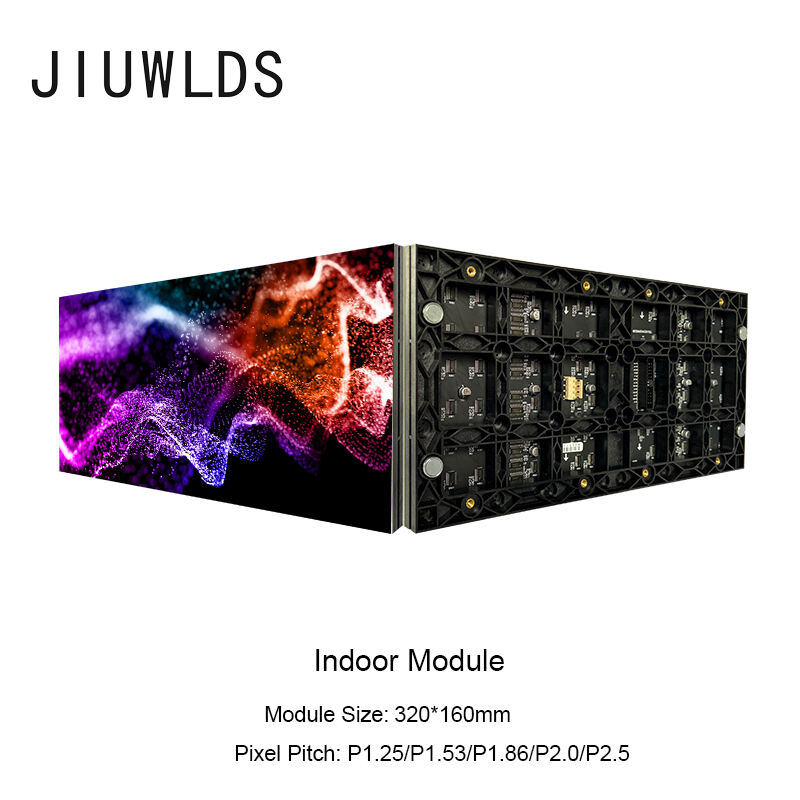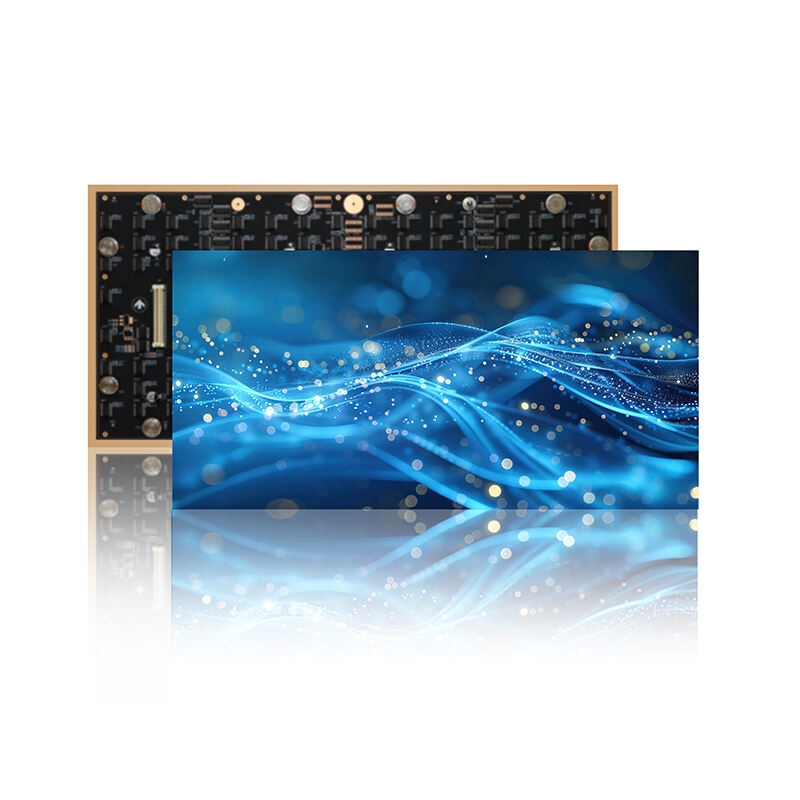Top Features of Modern LED Rental Displays for Event Promotion
High-Resolution Visual Impact of LED Rental Displays
Pixel Density and Image Clarity for Audience Engagement
Pixel density is a crucial factor in the performance of LED rental displays, significantly influencing image clarity and audience perception. The term "pixel density" refers to the number of pixels per square inch on a display screen, with higher densities translating to finer details and sharper images. In the context of LED rental displays, maintaining a high pixel density ensures that even the minutest details in visual content are vivid and distinct.
For instance, at events like trade shows or concerts where high-resolution visuals are paramount, a high pixel density allows for intricate designs and text to be readily legible, thereby enhancing audience engagement. Industry standards often recommend a pixel pitch of less than 4mm for indoor events and up to 10mm for outdoor events, as their clarity impacts how far an audience can be from the screen without losing image fidelity. Case studies reveal that displays with optimal pixel density not only captivate viewers but also enhance overall event satisfaction and effectiveness.
Adaptive Brightness for Indoor/Outdoor Visibility
Adaptive brightness technology is an innovation in LED rental displays that ensures visibility in varying light conditions, both indoors and outdoors. This feature allows displays to automatically adjust their brightness levels, ensuring the content remains visible and engaging regardless of environmental lighting.
Studies and expert opinions affirm the efficacy of adaptive brightness in maintaining audience engagement. For example, one study highlighted how displays with adaptive brightness experienced a 30% increase in audience retention compared to those without. This technology becomes particularly useful in outdoor settings where sunlight intensity changes throughout the day, ensuring that visuals remain crisp and clear. Statistics consistently underscore a strong correlation between visibility ensured by adaptive brightness and improved audience interaction during events.
4K+ Resolution Capabilities in Modern LED Screen Rentals
The advent of 4K+ resolution in LED screen rentals marks a significant leap in delivering stunning visuals for large-scale events. Known for providing unparalleled clarity and detail, 4K resolution enhances the viewer experience, especially in concert settings and large conferences, where large-screen displays are prevalent.
Higher resolution screens revolutionize event experiences by offering four times the detail and sharpness of traditional HD displays. This results in lifelike images that grab and retain audience attention. Various event organizers, like those in music festivals and corporate gatherings, have reported higher audience satisfaction and engagement levels following the deployment of 4K+ LED displays. Their capacity to provide seamless and vibrant visuals speaks volumes about modern LED technology's contribution to elevating the visual standard of events across diverse settings.
Flexible Installation and Customization Options
Modular Design for Tailored Display Configurations
Modular design in LED rental displays offers tremendous flexibility, allowing for customized configurations that adapt to various venue sizes and layouts. This design feature is particularly advantageous for events where space needs and layouts are unpredictable. Modular setups can be quickly adjusted or expanded based on event requirements, enhancing both convenience and visual appeal. For instance, an LED rental display at a trade show might utilize a modular design to create a dynamic, engaging space that attracts visitors. The ease of transport, assembly, and disassembly further underscores the advantages of modular systems, making them ideal for event crews managing multiple events in a single day. The success of such setups is evident in various events, from compact conference rooms to sprawling outdoor festivals, showcasing the versatility of these configurations.
Curved LED Display Screen Rentals for Immersive Layouts
Curved LED displays bring a new level of engagement and immersion to events, transforming standard screen setups into captivating visual experiences. These displays are particularly effective in exhibitions and stage presentations, where they can wrap around a booth or stage, creating an enveloping visual field for the audience. This design enhances the overall sensory experience, drawing viewers into the content being displayed. Creative applications include using curved screens as part of a 360-degree display in an art installation or as a dynamic backdrop for a stage performance. The shape of the display significantly influences audience attention spans, with studies indicating that unconventional screen shapes, like curved displays, can boost viewer retention and engagement, providing added value to event organizers seeking a memorable impact.
Scalable Solutions from 10sqft to Stadium-Sized Setups
Scalability is a key feature of rental LED displays, providing solutions that range from small venues to large stadiums. This adaptability ensures that each event, regardless of size, can deliver a high-impact visual experience. Recent events highlight the importance of scaling, such as music festivals, where audience size and venue dimensions require scalable solutions. For small venues, a compact setup suffices, while stadiums might demand expansive displays visible from across the arena. Logistical considerations for scaling include transport, installation time, and power requirements – factors that modern technology helps streamline, ensuring efficient scalability. By leveraging the scalable nature of LED rental displays, event organizers can accommodate diverse audiences while maintaining an engaging and immersive visual experience.
Rapid Setup and Teardown Efficiency
Tool-Free Assembly Systems for Event Crews
Tool-free assembly systems are revolutionizing event setups and teardowns by saving time and labor costs. With these systems, event crews can quickly assemble and disassemble LED displays without the need for specialized tools or equipment, significantly reducing setup times and costs. For instance, studies show a 30% increase in efficiency when using tool-free systems, enabling faster turnarounds between events. Testimonial evidence from professionals in the field highlights how these systems have simplified their work processes, allowing for smoother and more efficient operations at large-scale events. This advancement in technology helps event planners meet tight schedules with ease, ensuring optimal use of time and resources.
Lightweight Aluminum Frames for Fast Deployment
Lightweight aluminum frames offer substantial advantages, contributing to the rapid deployment and reduced transport costs of LED rental displays. These materials ensure that transportation is more cost-effective, as lighter frames translate to lower shipping expenses. Exemplifying this, major events like music festivals have benefitted from using aluminum frames, experiencing swift installations and dismantling of LED displays. Experts in the field emphasize the balance between durability and weight provided by aluminum, ensuring sturdy setups without compromising on ease of transport. This pragmatic choice enhances preparedness and flexibility, enabling seamless event execution and a smooth logistics process.
Pre-Configured Content Management Integration
Pre-configured content management systems streamline operations, allowing event staff to make swift adjustments to LED displays during live events. These platforms integrate seamlessly, enabling instant updates and reducing the stress of manual content management under tight timelines. Technologies like disguise's media server facilitate these integrations, providing user-friendly interfaces to modify and enhance content even as the event unfolds. Case studies, such as those from recent conferences, demonstrate how pre-configured systems improved delivery times and boosted content quality, ensuring viewers have a captivating experience. As a result, the efficiency and effectiveness of live event setups are significantly enhanced, making these systems indispensable in contemporary event production.
Energy-Efficient Operation
Low-Power Consumption Without Compromising Brightness
Modern LED technologies skillfully balance low power consumption and high brightness levels. The latest advancements have allowed LED rental displays to illuminate large spaces while using significantly less energy than traditional lighting systems. Studies consistently show that these screens can reduce energy usage by substantial margins without sacrificing performance. Event organizers opting for these energy-efficient materials benefit from reduced electricity costs and contribute positively to environmental conservation, reinforcing the importance of sustainability in event planning.
Smart Cooling Systems in Outdoor Rental LED Displays
Smart cooling systems are crucial for protecting LED displays during outdoor events, where they are exposed to harsh sunlight and high temperatures. These systems help prevent overheating and sun damage, ensuring optimal screen performance. For instance, outdoor concerts and festivals have reported significant improvements in screen reliability and clarity due to these cooling solutions. Experts emphasize that these systems not only extend the lifespan of LED displays but also maintain their vibrant visuals, making them indispensable for outdoor rental technology.
Solar-Powered Configuration Options
The trend toward solar-powered LED rental displays is gaining momentum as more events seek sustainable solutions. These setups drastically reduce carbon footprints and energy costs by harnessing the power of the sun. Statistics indicate that solar-powered options can lower emissions by substantial percentages, making them a preferred choice for eco-conscious events. Successful implementations at music festivals and outdoor exhibitions have demonstrated the effectiveness and reliability of solar-powered LED screens in delivering high-quality visual experiences while promoting sustainability.
Durability for Indoor and Outdoor Event Demands
IP66-Rated Protection Against Weather Elements
IP66-rated LED displays are crucial for outdoor events, where unpredictable weather conditions can impact performance. This rating ensures the screens are both dust-tight and resistant to powerful water jets, offering robust protection against the elements. According to data from industry studies, IP66-rated LEDs have demonstrated exceptional performance in harsh weather, maintaining functionality in rain, wind, and dust storms. For event planners, choosing IP66-rated displays translates to reliability in outdoor settings, reducing the risks associated with weather-related damages and ensuring seamless operations. This durability provides peace of mind and is a critical factor when selecting rental displays that need to withstand the elements over extended periods.
Impact-Resistant Surfaces for High-Traffic Venues
Impact-resistant surfaces are essential for LED displays in bustling areas, where bumps and knocks are inevitable. This feature significantly reduces maintenance costs and minimizes downtime due to damage. Venues such as stadiums and conference centers have widely adopted impact-resistant screens to prevent disruptive damage, enhancing event quality and sustainability. Industry standards highlight the importance of this feature, noting its role in maintaining image quality and functionality under physical stress. Expert opinions emphasize the necessity of impact resistance, highlighting how it protects the investment and ensures displays remain intact even in the busiest settings.
24/7 Operation Capabilities for Multi-Day Festivals
Continuous operation is vital for LED displays at multi-day festivals, where consistency and reliability are crucial. Such events demand displays that can operate without interruption for long periods, ensuring ongoing engagement. Data from numerous festivals show that rental LED displays met the challenge of 24/7 operation, maintaining high performance without overheating or failing. Event organizers often cite operational reliability as a top priority, recognizing its impact on the overall success and viewer experience. Renting LED screens with robust 24/7 capabilities means we can confidently support dynamic, non-stop activities without worrying about potential hiccups or technical failures during critical moments.
Multi-Application Versatility
Stage Backdrops and Interactive Floor Displays
LED display screens offer remarkable versatility in enhancing stage designs. These displays function as captivating backdrops and interactive floor installations, revolutionizing stage presentations. Utilizing LED screens as dynamic backdrops provides an engaging visual experience by running live content, synchronized visuals, or themed graphics. For example, concerts or theatrical performances often use LED backdrops to enhance the storytelling aspect, contributing to immersive audience experiences. Additionally, interactive LED floor displays allow performers to engage more closely with their audiences, creating immersive and memorable performances. Industry experts have noted innovative uses of LED technology in transforming stage designs, proving its value in creating visually stunning events.
Sponsorship Activation Through Dynamic Content Zones
Dynamic LED displays are crucial for enhancing sponsorship visibility and audience interaction at events. These screens transform static sponsorship spots into interactive zones, boosting brand engagement. Events that have successfully integrated LED rental displays show increased sponsor satisfaction and audience participation. For instance, integrating sponsor logos, live social media feeds, and interactive games during intervals or breaks can elevate the sponsor's presence. Studies have shown that dynamic content can increase a sponsor's perceived value, offering better return on investment. The flexibility and adaptability of LED displays make them indispensable for creating engaging sponsorship zones.
Real-Time Social Media Integration Features
The integration of real-time social media content into LED displays has become a powerful tool in modern event management. This feature significantly boosts audience engagement by allowing attendees to share their experiences live, thereby fostering a sense of community. Events featuring LED screens displaying live social media feeds have experienced higher engagement rates, with audiences interacting more with both the event and each other. For example, music festivals and sports events often utilize this approach to keep audiences engaged by displaying live tweets, Instagram posts, or polls. The result is an enriched event atmosphere where audience participation is continually encouraged, leading to increased online and offline interaction.







 Hot News
Hot News